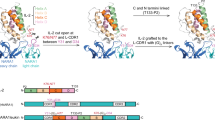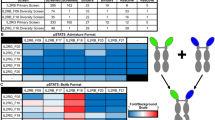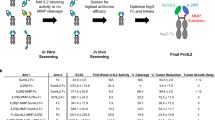Abstract
Intercellular cell adhesion molecule-1 (ICAM-1) is a cell-surface glycoprotein capable of eliciting bidirectional signals that activate signalling pathways in leukocytes, endothelial, and smooth muscle cells. Gene transfer of xenogeneic ICAM-1 into EL-4 lymphomas causes complete tumor rejection; however, it is unknown whether the mechanism responsible involves the “foreignness” of the ICAM-1 transgene, bidirectional signalling events, ICAM-1-receptor interaction, or a combination of the latter. To begin to address this question, we constructed four different therapeutic expression vectors encoding full-length ICAM-1, and forms in which the N-terminal ligand-binding domains and cytoplasmic tail had been deleted. Mouse EL-4 tumors (0.5 cm in diameter), which actively suppress the immune response, were significantly inhibited in their growth following injection of expression plasmids encoding either full-length xenogenic (human) ICAM-1, or a functional cytoplasmic domain-deficient form that retains ligand-binding activity. Efficacy of ICAM-1-mediated antitumor immunity was significantly augmented by administration of the antivascular drug 5,6-dimethylxanthenone-4-acetic acid (DMXAA), which suppressed blood supply to the tumor, leading to enhanced leukocyte infiltration, and complete tumor eradication in a gene dosage and CD8+ T cell and NK cell-dependent fashion. Generation of potent cytotoxic T cell (CTL)-mediated antitumor immunity was reflected by ICAM-1-facilitated apoptosis of tumor cells in situ. In contrast, nonfunctional ICAM-1 lacking the N-terminal ligand-binding Ig domain failed to generate antitumor immunity, even in the presence of DMXAA. These studies demonstrate that ICAM-1-stimulated antitumor immunity can overcome tumor-mediated immunosuppression, particularly when employed in combination with an attack on the tumor vasculature. The ligand-binding domain of ICAM-1 is essential for generating antitumor immunity, whereas the cytoplasmic domain and bidirectional activation of tumor signalling pathways are not essential.
This is a preview of subscription content, access via your institution
Access options
Subscribe to this journal
Receive 12 print issues and online access
$259.00 per year
only $21.58 per issue
Buy this article
- Purchase on Springer Link
- Instant access to full article PDF
Prices may be subject to local taxes which are calculated during checkout





Similar content being viewed by others
References
Townsend SE, Allison JP . Tumor rejection after direct costimulation of CD8+ T cells by B7 transfected melanoma cells. Science. 1993;259:368–370.
Chen L, Ashe S, Brady WA, et al. Costimulation of anti-tumor immunity by the B7 counterreceptor for the T lymphocyte molecules CD28 and CTLA-4. Cell. 1992; 71:1093–1102.
Baskar S, Ostrand-Rosenberg S, Nabavi N, et al. Constitutive expression of B7 restores immunogenicity of tumor cells expressing truncated MHC class II molecules. Proc Natl Acad Sci USA. 1993;90:5687–5690.
Hodge JW, Abrams S, Schlom J, et al. Induction of antitumor immunity by recombinant vaccinia viruses expressing B7.1 or B7.2 costimulatory molecules. Cancer Res. 1994;54:5552–5555.
Huang AY, Bruce AT, Pardoll DM, et al. Does B7.1 expression confer antigen-presenting cell capacity to tumors in vivo? J Exp Med. 1996;183:769–776.
Kanwar JR, Berg RW, Lehnert K, et al. Taking lessons from dendritic cells: multiple xenogeneic ligands for leukocyte integrins have the potential to stimulate anti-tumor immunity. Gene Therapy. 1999;6:1835–1844.
Wei K, Wilson JG, Jurgensen CH, et al. Xenogeneic ICAM-1 gene transfer suppresses tumorigenicity and generates protective antitumor immunity. Gene Therapy. 1996;3:531–541.
D'Angelica M, Tung C, Allen P, et al. Herpes simplex virus (HSV)-mediated ICAM-1 gene transfer abrogates tumorigenicity and induces anti-tumor immunity. Mol Med. 1999;5:606–616.
Kikuchi T, Joki T, Akasaki Y, et al. Induction of antitumor immunity using intercellular adhesion molecule 1 (ICAM-1) transfection in mouse glioma cells. Cancer Lett. 1999;142:201–206.
Uzendoski K, Kantor JA, Abrams SI, et al. Construction and characterization of a recombinant vaccinia virus expressing murine intercellular adhesion molecule-1: induction and potentiation of antitumor responses. Hum Gene Therapy. 1997;8:851–860.
Sunami T, Yashiro M, Chung KH . ICAM-1 (intercellular adhesion molecule-1) gene transfection inhibits lymph node metastasis by human gastric cancer cells. Jpn J Cancer Res. 2000;91:925–933.
Staunton DE, Marlin SD, Stratowa C, et al. Primary structure of ICAM-1 demonstrates interaction between members of the immunoglobulin and integrin supergene families. Cell. 1988;52:925–933.
Staunton DE, Dustin ML, Erickson HP, et al. The arrangement of the immunoglobulin-like domains of ICAM-1 and the binding sites for LFA-1 and rhinovirus. Cell. 1990;61:243–254.
Diamond MS, Staunton DE, Marlin SD, et al. Binding of the integrin Mac-1 (CD11b/CD18) to the third immunoglobulin-like domain of ICAM-1 (CD54) and its regulation by glycosylation. Cell. 1991;65:961–971.
Zuckerman LA, Pullen L, Miller J . Functional consequences of costimulation by ICAM-1 on IL-2 gene expression and T cell activation. J Immunol. 1998;160:3259–3268.
Salomon B, Bluestone JA . LFA-1 interaction with ICAM-1 and ICAM-2 regulates Th2 cytokine production. J Immunol. 1998;161:5138–5142.
Deeths MJ, Mescher MF . ICAM-1 and B7.1 provide similar but distinct costimulation for CD8+ T cells, while CD4+ T cells are poorly costimulated by ICAM-1. Eur J Immunol. 1999;29:45–53.
Gaglia JL, Greenfield EA, Mattoo A, et al. Intercellular adhesion molecule 1 is critical for activation of CD28-deficient T cells. J Immunol. 2000;165:6091–6098.
Carpen O, Pallai P, Staunton DE, et al. Association of intercellular adhesion molecule-1 (ICAM-1) with actin-containing cytoskeleton and alpha-actinin. J Cell Biol. 1992;118:1223–1234.
Chirathaworn C, Tibbetts SA, Chan MA, et al. Cross-linking of ICAM-1 on T cells induces transient tyrosine phosphorylation and inactivation of cdc2 kinase. J Immunol. 1995;155:5479–5482.
Rothlein R, Kishimoto TK, Mainolfi E . Cross-linking of ICAM-1 induces co-signaling of an oxidative burst from mononuclear leukocytes. J Immunol. 1994;152:2488–2495.
Geissler D, Gaggl S, Most J, et al. A monoclonal antibody directed against the human intercellular adhesion molecule (ICAM-1) modulates the release of tumor necrosis factor-α, interferon-γ and interleukin 1. Eur J Immunol. 1990;20:2591–2596.
Poudrier J, Owens T . CD54/intercellular adhesion molecule 1 and major histocompatibility complex II signaling induces B cells to express interleukin 2 receptors and complements help provided through CD40 ligation. J Exp Med. 1994;179:1417–1427.
Adamson P, Etienne S, Couraud P-O, et al. Lymphocyte migration through brain endothelial cell monolayers involves signaling through endothelial ICAM-1 via a rho-dependent pathway. J Immunol. 1999;162:2964–2973.
Lawson C, Ainsworth M, Yacoub M, et al. Ligation of ICAM-1 on endothelial cells leads to expression of VCAM-1 via a nuclear factor-κB-independent mechanism. J Immunol. 1999;162:2990–2996.
Etienne S, Adamson P, Greenwood J, et al. ICAM-1 signaling pathways associated with rho activation in microvascular brain endothelial cells. J Immunol. 1998;161:5755–5761.
Kanwar JR, Kanwar R, Pandey S, et al. Vascular attack by 5,6-dimethylxanthenone-4-acetic acid combined with B7.1-mediated immunotherapy overcomes immune-resistance and leads to the eradication of large tumors. Cancer Res. 2001;61:1948–1956.
Sun X, Kanwar JR, Leung E, et al. Gene transfer of antisense hypoxia inducible factor-1α enhances the therapeutic efficacy of cancer immunotherapy. Gene Therapy. 2001;8:638–645.
Sun X, Kanwar JR, Leung E, et al. Angiostatin enhances B7.1-mediated cancer immunotherapy independently of effects on vascular endothelial growth factor expression. Cancer Gene Therapy. 2001;8:719–727.
Kanwar JR, Shen WP, Berg R, et al. Effect of survivin antagonists on the growth of established tumors and B7.1 immunogene therapy. J Natl Cancer Inst. 2001;93:1541–1552.
Kayar SR, Archer PG, Lechher AJ, et al. Evaluation of the concentric-circles method for estimating capillary-tissue diffusion distances. Microvascular Res. 1982;24:342–353.
Maxwell PH, Dachs GU, Gleadle JM, et al. Hypoxia-inducible factor-1 modulates gene expression in solid tumors and influences both angiogenesis and tumor growth. Proc Natl Acad Sci USA. 1997;94:8104–8109.
Ding I, Sun JZ, Fenton B, et al. Intratumoral administration of endostatin plasmid inhibits vascular growth and perfusion in MCa-4 murine mammary carcinomas. Cancer Res. 2001;61:526–531.
Wei K, Wilson JG, Jurgensen CH, et al. Xenogeneic ICAM-1 gene transfer suppresses tumorigenicity and generates protective antitumor immunity. Gene Therapy. 1996;3:531–541.
Katsanis E, Bausero MA, Xu H, et al. Transfection of the mouse ICAM-1 gene into murine neuroblastoma enhances susceptibility to lysis, reduces in vivo tumorigenicity and decreases ICAM-2-dependent killing. Cancer Immunol Immunother. 1994;38:135–141.
Burno DK, Fabian DF, Lefor AT . ICAM-1 increases in vitro adhesion and cytotoxicity in a murine fibrosarcoma. J Surgical Res. 1996;60:398–402.
Doty RT, Clark EA . Subcellular localization of CD80 receptors is dependent on an intact cytoplasmic tail and is required for CD28-dependent T cell costimulation. J Immunol. 1996;157:3270–3279.
Chong AS, Boussy IA, Jiang XL, et al. CD54/ICAM-1 is a costimulator of NK cell-mediated cytotoxicity. Cell Immunol. 1994;157:92–105.
Baguley BC, Ching LM . Immunomodulatory actions of xanthenone anticancer agents. BioDrugs. 1997;8:119–127.
Bibby MC, Double JA . Flavone acetic acid-from laboratory to clinic and back. Anti-Cancer Drugs. 1993;4:3–17.
Mahadevan V, Malik ST, Meager A, et al. Role of tumor necrosis factor in flavone acetic acid-induced tumor vasculature shutdown. Cancer Res. 1990;50:5537–5542.
Ruegg C, Yilmaz A, Bieler G, et al. Evidence for the involvement of endothelial cell integrin alphaVbeta3 in the disruption of the tumor vasculature induced by TNF and IFN-gamma. Nature Med. 1998;4:408–414.
Acknowledgements
We are grateful to Professors Bill Denny and Bruce Baguley (Auckland Cancer Society Research Centre) for supplying the DMXAA. This work was supported by grants from the Royal Society of New Zealand, the Cancer Society of New Zealand, the Health Research Council of New Zealand, the Wellcome Trust, the Lottery Grants Board of New Zealand, and the Maurice and Phyllis Paykel Trust. GWK was supported by a James Cook Research Fellowship funded by the Royal Society of New Zealand.
Author information
Authors and Affiliations
Corresponding author
Rights and permissions
About this article
Cite this article
Kanwar, J., Berg, R., Yang, Y. et al. Requirements for ICAM-1 immunogene therapy of lymphoma. Cancer Gene Ther 10, 468–476 (2003). https://doi.org/10.1038/sj.cgt.7700590
Received:
Published:
Issue Date:
DOI: https://doi.org/10.1038/sj.cgt.7700590
Keywords
This article is cited by
-
The tumor as an organ: comprehensive spatial and temporal modeling of the tumor and its microenvironment
BMC Bioinformatics (2016)
-
Genomic characterization of explant tumorgraft models derived from fresh patient tumor tissue
Journal of Translational Medicine (2012)
-
Proteasome inhibitor bortezomib targeted tumor–endothelial cell interaction in T-cell leukemia/lymphoma
Annals of Hematology (2011)
-
‘Iron‐saturated’ lactoferrin is a potent natural adjuvant for augmenting cancer chemotherapy
Immunology & Cell Biology (2008)
-
Intramuscular delivery of antiangiogenic genes suppresses secondary metastases after removal of primary tumors
Cancer Gene Therapy (2005)



